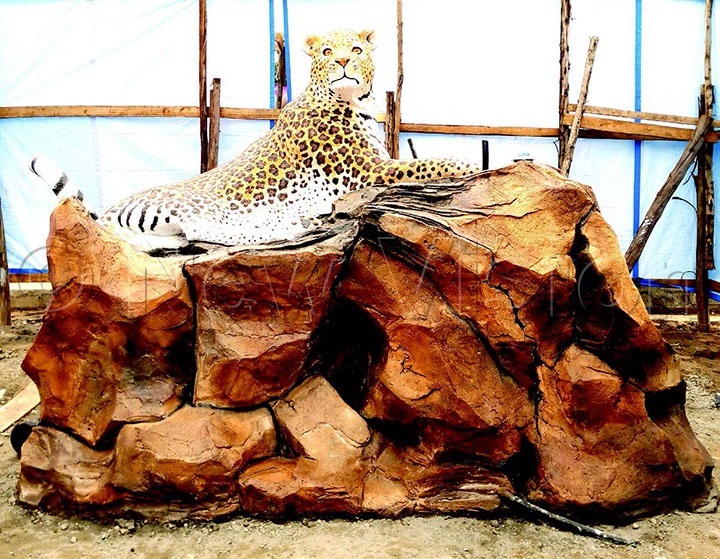Excitement as leopard is unveiled as Lugbara emblem
The emblem is near completion and Arua city residents, as well as travellers from neighbouring districts and parts of eastern DR Congo and South Sudan are flocking Arua to see it.
The paramount chief of the Lugbara and his executive have embraced the construction of an emblem for the Lugbara people — a leopard.
The leopard is a calm animal that is closely related with the Lugbara during occasions held at night, such as funerals, traditional marriages and white ants seasons and providing security for those who walked at night, among others.
The emblem is near completion and Arua city residents, as well as travellers from neighbouring districts and parts of eastern DR Congo and South Sudan are flocking Arua to see it.
During the public viewing on Tuesday, Godfrey Okuonzi, the safety and environmental officer for Development Infrastructure, the contractor, said the construction of the monument took one month.
The leopard rests on a rock to depict peace as it has done previously for the Lugbara, but once provoked, it would get angry. It will be surrounded by a stream.
"People's doubts over the project delaying have been put to rest," Okuonzi said, adding that all that is left is fixing the water, fence and lights.

He said the project cost sh3m, including hiring the designers and buying materials. Other costs are still being calculated, with a few components yet to be completed. Okuonzi said once kept well, the monument will last 200 years.
The engineers have designed a stagnant water spot at the monument, which will separate it from the public, hence protect it from damage. Besides the leopard monument, a tower is also being constructed. The works, undertaken by Development Infrastructure, has changed the face of Arua city near the main roundabout along Arua-Pakwach highway.
Ratib Adebuga, a Lugbara, said this is the culture of the Lugbara. From 1927, some animals used to disturb the Lugbara, so they befriended the leopard, which protected and escorted them to Sudan whenever they travelled.
It, therefore, became a protection animal for the people. He cited the former gender minister, Zoe Bakoko Bakoru, who keeps a leopard at her home for security. Adebuga urged the Lugbara who may be green about their culture, to return home, learn and embrace it. Denis Adriko, 28, said: "The emblem will remind me of my culture, which I will pass on to my children in future."
Meanwhile, Flavia Eyotaru, 18, said she is proud that the leopard had been designed to remind the Lugbara of their culture.
BULL EMBLEM PROPOSAL REJECTED
Lugbara chiefdom (Agofe), however, rejected the proposed bull emblem to replace the leopard, which was chosen as a sign of unity in the four clans of Lugbara, Alur, Kakwa and Madi, as the animal was found across the West Nile region.
The prime minister of the Lugbara Kari (or the in-charge), also known as the "Apife", Ismail Tuku, said their great grandfathers sat with the whites and agreed that the leopard be the emblem and the land be called West Nile, with its headquarters at Arua because it is in the centre of West Nile.
According to Tuku, the Lugbara in the diaspora rejected the proposal to have a bull as the emblem. He said following consultations with the elders, the leopard remained the unifying factor and symbol peace for the Lugbara.
"Any clan can use anything as its emblem, but we should not replace the leopard," he said. Tuku, who inspected the works on the emblem, blessed it and okayed the design.
He said chiefs from different clans of Vurra, Terego, Madi, Ayivu and representatives of the Kebu and Alur clan equally blessed the emblem. Jafar Alekua, the Lugbara Kari clerk, said the relationship between the Lugbara and the leopard was formed when it protected them at night.
"I used to move at night from Ociba trading centre to Arua Primary School to read books in 1962. The places were about 3km apart, but the leopard would escort me, then return to rest at River Osu. When I was done with reading, it would escort me back home," Alekua said.
Lambadi Adroa, the chief of Terego chiefdom, blessed the emblem and warned the young generation against tampering with it, saying their great grandfathers were saved by the leopard when traps were laid to kill them during traditional marriages.
The king of Madi also disapproved plans to replace the leopard with a bull, and appealed to the people of Ayivu to respect it. In lower Madi, it is believed the leopard visits at night to mourn the dead together with humans.
"Whenever the Lugbara people would go for burials or when they would gather around the fire at night to tell stories to children, the leopard would join them silently and sit calmly with them.
However, when provoked, it would become violent, which is why the Lugbara lived with it peacefully," the king said.
The chief of Ayivu chiefdom, Manasseh Yuma Amuku, agreed with the rest of the kings and upheld the leopard as the symbol of the Lugbara, but said the emblem of the Ayivu is a bull, which will be designed and stationed at one of the roundabouts in Arua city.